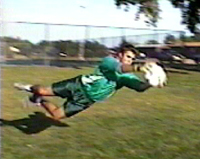
|
"Outstanding keeper instruction. This is a must for goalkeepers and coaches." — Ottawa Internationals S.C. web site, Ottawa, Canada |

|

|
|
|
Top |
Next: Advanced
Diving
|
Goalkeeping agility is the ability to put your body in strange positions, often in mid-air, while changing these positions very rapidly indeed.
-- Alan Wade, Coach Yourself Soccer
| CONTENTS | TRAINING SESSIONS |
|---|---|
|
Basic Principles
|
Collapsed Dives
Extension Dives |
 The dive can be the most spectacular save in soccer, with the goalkeeper
seemingly flying in out of nowhere to keep the ball from hitting the
net. It's an important part of the keeper's arsenal, but a keeper must
have sound fundamentals to perform a dive successfully.
The dive can be the most spectacular save in soccer, with the goalkeeper
seemingly flying in out of nowhere to keep the ball from hitting the
net. It's an important part of the keeper's arsenal, but a keeper must
have sound fundamentals to perform a dive successfully.
Diving should only be done as a last resort - good footwork and
positioning should eliminate the need to dive often.
![]() Beware the keeper who loves to
dive too much and dives even on what should be easy saves.
It looks impressive, but safety should come first.
Beware the keeper who loves to
dive too much and dives even on what should be easy saves.
It looks impressive, but safety should come first.
Basic Principles of Diving
Many of the fundamentals of footwork and catching also apply to diving: stay square to the shooter, move forward towards the ball, use the hands to catch the ball. For diving, they are expanded a little.
- Use good footwork to get into position to dive. Small shuffle steps, or occasionally even a quick crossover, need to be used to get the body into the proper range to make the dive.
- Move forward at an angle into the dive.
The first step going into a dive should be sideways towards the ball and forward at roughly a 30-degree angle. This gives the keeper the proper angle to deflect balls away from goal.The Right Angle:
Just why do soccer goalkeepers dive backwards? The explanation, and a Java applet that lets you cover all the angles. One of the biggest problems for
keepers is diving backwards - they put their weight on their heels and
stretch backwards, and often will deflect the ball back into the side
netting. Don't let this happen!
One of the biggest problems for
keepers is diving backwards - they put their weight on their heels and
stretch backwards, and often will deflect the ball back into the side
netting. Don't let this happen!
 Make sure they start with
their weight forward on their toes and step forwards into the dive.
Make sure they start with
their weight forward on their toes and step forwards into the dive.
- Get low and shoot out towards the ball. Drive with the near leg, starting low to generate power. This should come as a natural progression after the step forward at the angle.
- Stay
square while diving and after landing on the ground.
Even while in midair, the keeper's body should be square to the ball.
Why?
 Because this gives
them the best catching position, gets the largest part of their
body behind the ball, and will have them land on their hip and side
which is the safest landing position.
Same thing goes after they are on the ground.
Because this gives
them the best catching position, gets the largest part of their
body behind the ball, and will have them land on their hip and side
which is the safest landing position.
Same thing goes after they are on the ground.
 Do not allow the keeper to
turn face-down while making the catch and land on their stomach! Not
only can the ball slip through, but landing on the ball can injure
the keeper. Similarly, don't let them roll over on their back
after the catch is made.
Do not allow the keeper to
turn face-down while making the catch and land on their stomach! Not
only can the ball slip through, but landing on the ball can injure
the keeper. Similarly, don't let them roll over on their back
after the catch is made.
- Catch the ball with the hands first, then cushion the fall.
Many young keepers are afraid of falling to the ground while diving
and fail to make the catch in the first place.
 Always make the catch first,
with the hands in good catching position, then worry about landing.
If they have good technique and land on their side, it will hurt much
less. In addition, if they make a good catch and have the ball in their
hands, they can use the ball as a cushion to soften the landing.
Always make the catch first,
with the hands in good catching position, then worry about landing.
If they have good technique and land on their side, it will hurt much
less. In addition, if they make a good catch and have the ball in their
hands, they can use the ball as a cushion to soften the landing.
The Collapsed Dive or "Cradling"
The collapsed dive or "cradling" is used on balls fairly close to the goalkeeper but far enough to the side that just reaching out to make the catch does not get any of the body behind the ball. The intent is to move the entire body behind the ball and get the hands in good catching position.
![]()
![]() The sequence of events on a collapsed dive goes like this:
The sequence of events on a collapsed dive goes like this:
- Use quick footwork to get into proper diving position
- Step to the side the ball is on, forward at an angle
- Use the near leg push to drive to the ball
- Get both hands to the ball to make the catch, using a good "W" catch
- Collapse softly to the ground, putting the ball down first to cushion the fall and landing on the side (hip and shoulder)
Extension and Aerial Dives
For balls further away, the keeper must extend and get into the air at the same level as the ball. Again, the whole idea is to get the body behind the ball and the hands in good catching position.
The technique is similar to a collapsed dive, except that now the keeper must generate extra power to drive the body both horizontally and vertically to get into catching position. In addition, the landing will be a bit more difficult since the keeper will be "falling" from higher up.
![]()
![]() The technique for aerial or extension dives is this:
The technique for aerial or extension dives is this:
- Use quick footwork to get into proper diving position
- Step to the side the ball is on, forward at an angle
- Drive outwards, and upwards if necessary, with the near foot, starting low and exploding for maximum height and distance - the goal is to get the body at the same height as the ball. For low balls, no height is needed so don't waste energy going up to make "rainbow", just drive horizontally.
- Bring the knee of the other leg across the body for additional boost
- Get both hands to the ball to make the catch, using a good "W" catch
- Bring the ball to the ground first to cushion the landing, then land as softly as possible on the side (hip and shoulder)
Again, the diving technique attempts to get the body and hands into position
to make a good clean catch. In fact, when a dive is properly executed,
![]() the body should be in the same
position as when making an easy head-high save standing up. The only
difference is that you are horizontal three feet off the ground!
Of course, it can be difficult for
young keepers (especially girls) to achieve great height or distance, but
if they develop proper technique early the height and distance will come
with age and strength.
the body should be in the same
position as when making an easy head-high save standing up. The only
difference is that you are horizontal three feet off the ground!
Of course, it can be difficult for
young keepers (especially girls) to achieve great height or distance, but
if they develop proper technique early the height and distance will come
with age and strength.
The combination of stepping and driving with the near foot and then
getting extra boost from the other knee is often referred to as the
"power step".
Many young players, especially girls, will not have sufficient leg
strength to get airborne very well. That's okay - just introduce them
to the proper technique. A good power step and the ability to explode
to the ball will come in time.
![]() But don't let them omit the power step,
even if they can't generate much power now.
But don't let them omit the power step,
even if they can't generate much power now.
Also, many young or beginning goalkeepers will be afraid of the landing.
![]() Tell them to stop thinking so much and just do it!
Focus on getting to the ball and staying square and the landing will take
care of itself. This can be tough to get past, so be patient.
Tell them to stop thinking so much and just do it!
Focus on getting to the ball and staying square and the landing will take
care of itself. This can be tough to get past, so be patient.
However, ![]() be careful not to overtrain younger keepers when working on
diving, particulary aerial and extension diving. Introduce the basics
of proper technique, but don't push keepers who aren't ready for the
physical aspects of diving.
be careful not to overtrain younger keepers when working on
diving, particulary aerial and extension diving. Introduce the basics
of proper technique, but don't push keepers who aren't ready for the
physical aspects of diving.
Finally, if they don't come up with the ball, the keeper should be
ready to spring back to their feet immediately to make another save if
they can (the ball doesn't always end up in the goal when we miss!).
If possible,
![]() they should get back up without using their hands. Once the hands are
put down on the ground to push off, they become useless.
Quick recovery, with hands ready, can often keep the ball out of the
net.
they should get back up without using their hands. Once the hands are
put down on the ground to push off, they become useless.
Quick recovery, with hands ready, can often keep the ball out of the
net.
Quick Summary - Diving: |
Mistakes to Watch For: |
||||||||||
|
|
|
|
|
Top |
Next: Advanced
Diving
|